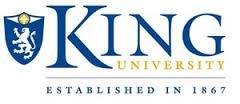

BRISTOL, Tenn. – With ever increasing technological advances, books today are more likely to be read on a computer, tablet, or e-reader. Many still prefer the printed word in the format of a bound book. This past summer, King University Associate Professor of History Dr. Martin Dotterweich spent four weeks participating in the 2013 National Endowment for the Humanities Summer Seminar in Manhattan, N.Y. The seminar, "Researching Early Modern Manuscripts and Printed Books," was hosted at the Graduate Center of the City University of New York.
"This experience was one of tremendous value," said Dotterweich. "One of the things I love about book history is you end up with a mix of people. Fellow seminar participants' fields of study included history, literature, art history, and library science. With book history, the fields all tend to overlap."
According to co-directors of the seminar, Clare Carroll, professor of Comparative Literature at the City University of New York, and Marc Caball, senior lecturer at University College Dublin, "The history of the book is one of the most dynamic and innovative fields of scholarship in the humanities today. Research in this area in recent years has furnished unique insights into the cultural, material, intellectual, and economic dimensions of manuscripts and books during the Renaissance. We designed this summer seminar to introduce scholars to the state of the art in terms of current scholarship across a range of topics as well as provide them with the practical skills which are essential to the appreciation of books and manuscripts as material objects in their own right. The seminar's location in New York enabled participants to draw on and benefit from the city's extraordinarily rich library and archival holdings in Renaissance material."
"In addition to discussion sessions and guest speakers, we visited several collections of rare books and manuscripts in New York City, including the New York Public Library, The Morgan Library, the Grolier Club, the Hispanic Society of America, the Burke Theological Library at Union Seminary, the Columbia University Library and the New York Academy of Medicine," said Dotterweich.
Dotterweich added, "Part of the seminar was spent learning the physical aspects of how books, both manuscript and print, were put together in the 15th and 16th centuries," commented Dotterweich. "We also spent time in discussions on what this means for early modern history. Book history pays attention to what the form of a book means for its historical importance. This introduced me to the academic field of material culture."
The 16 participants were given about a day and a half each week to work on their own personal research projects. "My research project was a study of the way people read the Bible in the 16th century, for which I looked at marks left by readers in several Bibles from the 1539 to 1541. My research was conducted mostly at the New York Public Library, and the American Bible Society Library."
Dotterweich spent much of his research time on the Great Bible. Commissioned by King Henry VIII in 1538, the Great Bible was the first royally authorized printed Bible in English. Although it was outlawed only a decade after it was first released, the Great Bible found its way into the hands of many people.
After participants presented their research findings, the seminar concluded with a reception at the CUNY Graduate Center hosted by the Renaissance Studies Certificate Program and the Renaissance Society of America, whose office is housed at the CUNY Graduate Center.